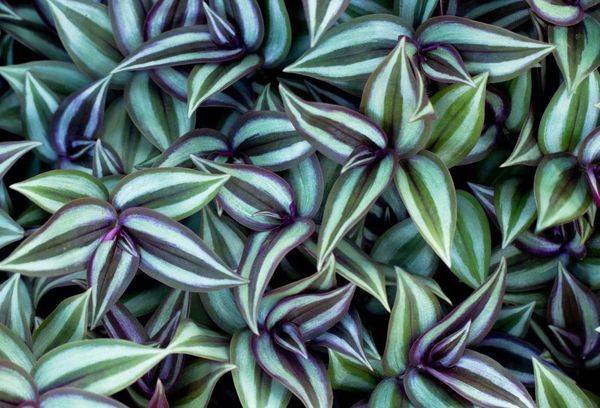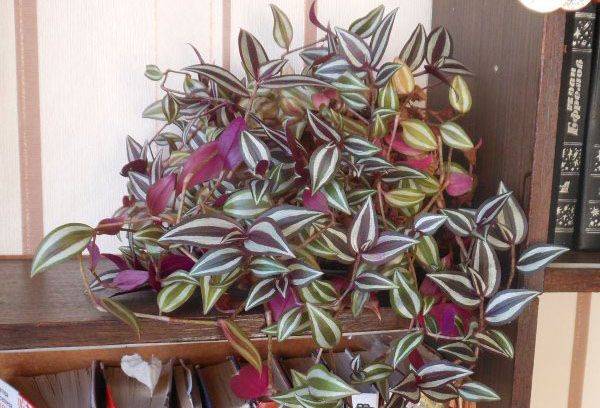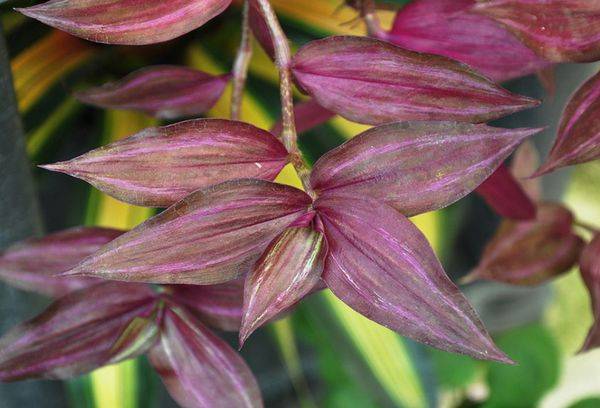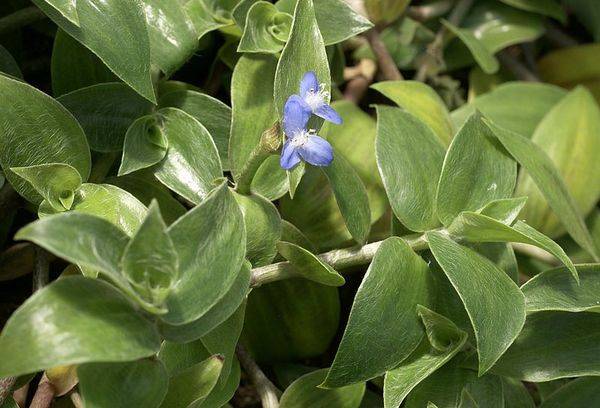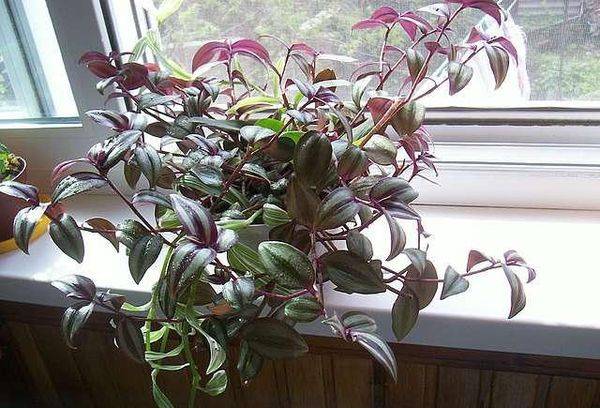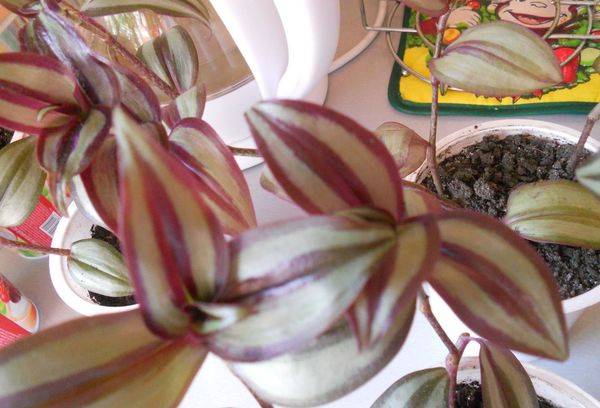Tradescantia zebrina - a green doctor on your windowsill
The bright colors and unusual shape make Tradescantia stand out from other indoor plants. Its foliage is silver and covered with longitudinal stripes of different colors. Tradescantia zebrina is grown as an hanging flower. It looks good in flowerpots and on balconies, on cabinets and window sills.
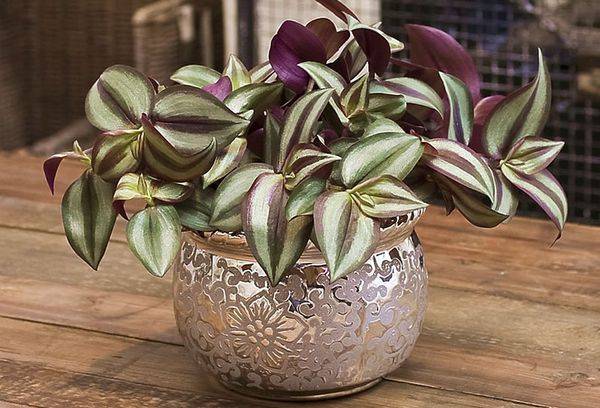
Unpretentious, rarely sick, resilient, she rightfully occupies an honorable place in the cohort of indoor flowers. Even a novice gardener can handle caring for it, but you still need to know some nuances.
Origin and description
The plant belongs to the Tradescantia genus and the Commelinaceae family, its closest relative is the golden mustache. Zebrina is an inhabitant of the humid tropics, with many medicinal properties and amazingly beautiful hanging shoots with dense and bright foliage. The ampel got its name precisely from the coloring of the leaf plates.
Tradescantia zebrina - external signs:
- the stem is long, smooth and dense to the touch, has a cylindrical cross-section;
- shoots are creeping, branched and cascading, stretching up to 1 meter in length;
- leaves are oval-shaped, with a pointed end and alternate;
- leaf color: the underside is bright purple, the outer side is divided by stripes of different shades - from dark green to rich crimson;
- The root system is superficial and penetrates shallowly into the soil.
In the wild, zebrina produces small lilac or pink flower stalks in spring. But it rarely blooms indoors.After 5-7 years, the flower loses its external attractiveness and beauty; it is grown again with the help of stem cuttings.
Indoor tradescantia purifies the air and saturates it with phytoncides. Its foliage has a bactericidal and disinfectant effect. This flower creates a favorable atmosphere in the house. Pets always feast on this plant.
Varieties and features
The Tradescantia genus is numerous; about 100 species are known, differing in height, shape and foliage. Zebrina was originally a separate genus, which was divided into species, but later botanists added the striped ampel to Tradescantia. Therefore, now it is more correct to talk about the type of zebrin and its varieties. Among them, there are three most suitable for home floriculture:
- Hanging zebrina, or trailing zebrina (Tradescantia zebrina pendula). Its peculiarity is large bare leaves, hanging stems and medicinal qualities. The bottom of the leaf blade is bright red, along the front side there are two wide silver-white stripes on a lush green background.
- Zebrina purpusii. This variety has blurred color boundaries on the leaf, from red to green, the lower part is purple. There is a slight, barely noticeable pubescence along the leaf blade.
- Zebrina flocculosa. It has soft and fleecy leaves of a whitish hue. The plant is characterized by a rapid growth rate.
Where to plant
Tradescantia zebrina grows happily at home. Caring for her will not take much time and effort. The plant loves light and moisture, but does not tolerate direct sunlight and excessive watering. Zebrina needs space and air, so pots with it are hung or placed higher.For the summer season, it would be a good idea to plant the flower in open ground - it will wonderfully decorate a flower bed and become a bright addition to any landscape design.
Advice
The magazine purity-en.htgetrid.com draws attention: when planting in a pot, you need to take into account that the roots of Tradescantia do not penetrate deeply and are located close to the surface. Therefore, the capacity required is quite wide.
Location. The ideal place for Tradescantia zebrina is eastern and western windows, where there is a lot of diffused daylight and there is no intense heat. A lack of light negatively affects the appearance of the flower - it weakens and withers.
Ambient conditions. The comfortable temperature range for zebrina is from +20 to +25° C. In the autumn-winter period, it can withstand coolness, but not lower than 13 degrees. Tradescantia is a moisture-loving plant; it requires abundant watering and regular spraying. Drying out the soil is not acceptable for it.
Spring and summer - the period of activity of Tradescantia, at this time it increases its green mass and grows. The winter season is characterized by dormancy; during this period the plant needs moderate temperatures and less watering. Zebrina willingly lives in open ground if the air temperature is acceptable for its growth and development.
How to care
Tradescantia zebrina is a valuable indoor plant. Its leaves are used for medicinal purposes - they treat wounds and burns, relieve pain, and make tinctures against gastrointestinal diseases. This plant is an air filter - it purifies and disinfects the air in the house. Experts say that this flower has a powerful energetic effect on people - it calms, improves mood and gives strength.
Basic care measures:
Watering. The soil in a pot of Tradescantia zebrina should always remain slightly moist, but not wet. Dry soil can cause leaves to wither, and stagnant moisture can cause roots to rot.
Feeding. Zebrina is fertilized only in the active growth stage - in spring and summer. A good feeding is complex fertilizers twice a week. Autumn and winter are a time of rest for the flower, so it is not fertilized and watered less.
Circumcision. To enhance branching, it is recommended to pinch the tops of side shoots. After pinching, the bushes look well-groomed - lush and compact. Old and dry branches are cut off regularly.
Transplantation and planting of Tradescantia. At a young age, zebrina is replanted annually; adult plants are replanted every 2-3 years. The plant requires loose soil with a neutral or slightly acidic reaction. The soil must contain humus and sand. The pot for Tradescantia should be shallow and of sufficient width with a good drainage layer at the bottom. Reproduction occurs by cuttings, which quickly take root in the ground.
The plant loves air, so it needs regular loosening and ventilation of the room. The flower does not grow well near smokers; nicotine has a detrimental effect on it.
Problems of growing tradescantia
Tradescantia is distinguished by its high viability and resistance to diseases. It is rarely affected by pests and spoils. If a plant is attacked by a spider mite, the leaves and stem should be washed with soapy water and dried in the open air. Plaque is removed in the same way.
Negative changes in appearance are most often associated with errors in caring for the zebra.
Advice
Flower shops usually sell small Tradescantia bushes that bloom intensely.At home, it is not recommended to feed the plant for the first time so that it adapts to new conditions. After 1-2 weeks, the flower can be transplanted into another pot.
Difficulties and solutions when growing Tradescantia:
- leaves fall off when there is a lack of moisture and excessive fertilization of the plant;
- color brightness is lost as a result of poor lighting;
- spots on the leaves occur due to lack of moisture;
- dryness at the tips of the leaves occurs due to insufficient air humidity in the room;
- the stems have become thinner and elongated - the reason lies in the incorrect location or weakness of the root system;
- An aged Tradescantia can be rejuvenated by cutting off the shoots to the very base near the soil surface.
Tradescantia zebrina can be revived and improved only by dividing the mother plant. The prepared part is immediately rooted in a new pot, providing moderate illumination and systematic watering. Tradescantia cuttings are kept in water for only a couple of days, after which they are rooted in suitable soil.
Tradescantia zebrina will fit well into any interior of an apartment, home or office. It is also good outdoors - on a flower bed, lawn, alpine hill or near a pond. Anyone, even a beginner in this business, can raise an unpretentious and life-loving zebrafish. Experienced flower growers distinguish Tradescantia from other indoor plants due to its variegated foliage, 100% survival rate and excellent adaptation, medicinal qualities and easy care.
